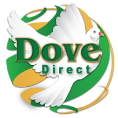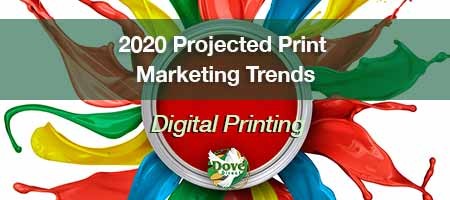Achieving Marketing Effectiveness in 2020
Welcome to the Dove Direct Print and Marketing Blog. Today's post, "Achieving Marketing Effectiveness in 2020," uncovers data that differentiates the effectiveness of marketing for brand building and sales activation. The two marketing strategies for brand building versus sales activation are simple to comprehend on their faces. Brand building is a long term effort, and sales activation is short term or more immediate.
Our Quote of the Day: "Your brand is what other people say about you when you're not in the room."
– Jeff Bezos, Amazon CEO
You may have read this excerpt before in a recent post; however, we find it valuable to repeat it in this context; "Renowned Effectiveness Expert Peter Field discovered that while print and digital platforms perform very well in delivering these business effects, it's the combination of the two formats that provides advertisers with a stronger multiplier effect — 3.5 times the uplift than when using just one platform."
Offline and Online is Becoming Blurred
Jonny Protheroe, Head of UK Market Insights, Google stated, "For consumers, the line between online and offline media is becoming increasingly blurred, and in some cases indistinguishable. So the core distinction between activation and brand building is a useful one, capturing the intended role of a piece of communication rather than the mechanism by which it was delivered. As the author notes, sales activation is not equivalent nor restricted to online-offline media but can be great for activation too. Likewise, online media can be great for brand building."
The Internet has reached a commercialization point, and together with the ongoing proliferation of mobile communications, including many other related digital technologies, they have collectively altered our world. Even though this evolution has been in full swing for over twenty years, most marketers and brands are continuing to grapple with what these evolutionary changes mean for marketing strategies.
Marketing Is Still a Numbers Game
The IPA Databank study suggests that marketing is primarily still a numbers game. The primary method by which brands continue to grow is through market penetration, not loyalty. Listed below is a snapshot of some interesting data the IPA report uncovered:
- Broad-reach campaigns are still the best way to drive market share, which is, in turn, a key driver of profit.
- The good news is that the digital revolution has increased the potential effectiveness of most forms of marketing, including traditional media.
- So, for firms that invest at the right level, and in the right way, mass marketing is working better than ever.
- Balancing long-term brand building and short-term sales activation is crucial. Around 60% brand and 40% activation is still the best combination.
- Video advertising, both on and offline, is the most effective brand-building form. Television is still the most effective medium, but online video makes it work even harder.
- Paid search and email emerge as the most effective sales activation channels.
- According to IPA Databank, "Of cases submitted in 2014 and 2016, 58% were supported by full econometric models."
The Data Process
"As with the previous report, the data source is the IPA Databank – the confidential data submitted alongside entries to the biennial IPA Effectiveness Awards competition. The data captured includes a comprehensive range of campaign inputs (such as strategy, media choices, and brand circumstances) and campaign outcomes (such as business effectiveness measures, efficiency, ROMI, and brand measures). Our analysis, in essence, examines how inputs, especially media choices, affect outcomes.
With very few exceptions, all the data used in this report is from the digital era, 1998 onwards. In some instances, we have split the sample into two time periods. The first (1998-2006) might be described as 'Web 1.0.' At that time, online marketing was rapidly expanding, but online video and social media had yet to play a significant role."
The second period (2007-2016), which one might call 'Web 2.0,' saw early online marketing techniques come into maturity, along with a significant expansion in the use of video and social. Much of the analysis covers two competitive reporting years between 2014 and 2016, with campaigns that typically ran between 2012 to 2015.
This period represents the new data captured since "The Long and the Short of It" was published and includes campaigns devised and executed in an increasingly mature digital landscape with a firmly established social media presence. For the time frame 2014-2016, 98% of the cases made use of online channels as an integrated part of the campaign, with 79% using social media.
Effectiveness Measurements
"The most frequently used measures of effectiveness in this report are the various business effects: profit, sales, market share, penetration, loyalty, and price sensitivity. Case study authors assess these measures on a four-point scale of magnitude: only top-box scores, those that are 'very large,' are used to identify high performers. These metrics are measured for at least a year and are therefore more indicative of long-term success."
"In our analysis, they are often blended into one metric – the number of business effects, which represents a broad measure of effectiveness that is relatively independent of the particular objectives of the campaign. This metric correlates closely with reported profit growth, making it a particularly useful measure of effectiveness. It also correlates with the extra share of voice (ESOV) efficiency, so this metric has very broad usefulness."
"The most important measure of effectiveness in the short term is 'activation' effects. In recent years, these are typically, online direct responses (transactional or intermediate) and their telephone or coupon equivalents in earlier periods. Again, only top-box scores are used to identify high performers. This metric is contrasted in this report with measures of long-term success to reveal factors that are short term or long term in nature."
Brand Building
Brand building takes over as the primary driver of growth from sales activation after six months. Therefore, it would appear that the two divergent marketing strategies could run simultaneously. And while it may be difficult to create two different types of campaigns, both of those campaign types will eventually merge into a single objective, that being brand building and sales activation.
Long Versus Short Term Effects
Brand building requires the creation of mental structures such as beliefs, memories associations, and the like, that will preposition prospects to select one brand over another. This is a long term effect whereby the strategy focuses on conditioning consumers through repeated exposures. A plan that takes much more time to realize. In short, the brand is speaking to potential customers long before they are ready to purchase.
It is also essential to keep in mind that the long term effect is positioned against the 1% Thin Theory, which postulates that only 1% of the target audience is ready to purchase at the time they see or read the message. Therefore, the long term effect relies more on emotional priming, and as a result, has a better chance of cutting through since it does not depend on the purchase cycle or purchase interest. The emotional tie-in has more impact versus purchasing messages, that for the most part, get deleted from actionable results. Those feel-good campaigns work best for long term effects.
Short Term Sales Activation
Conversely, marketing communications is also viable and should be used for sales activation. Sales activation is entirely different from brand building. The goal for short term sales activation is the ability to focus on prospects who are most likely to purchase very soon. What is interesting here is that the short term effect relies on exploiting existing brand equity to generate immediate sales. In this case, targeting is much tighter than mass appeal, and prospects are interested in rational persuasion, which serves a more pressing need, meaning that these prospects are more interested in what the brand is offering and what the brand message has to say.
This process is best served when utilizing information-rich media, and if possible, the inclusion of a response mechanism, thereby increasing the probability that more sales will happen. As opposed to the brand-building effect, short term sales activation is a short-term situation that requires much less exposure than brand building.
In addition, marketing materials and communications need to be created in a manner that offers prospects and customers a seamless, superior experience throughout the journey and during every touch point. A classic example of short term effect could simply be a piece of direct marketing collateral, that possibly includes an offer, such as a seasonal reminder, or a search-driven re-targeted online ad, or even a call-to-action to visit a particular digital destination.
Brand building is the more difficult of the two effects, and therefore requires more investment and various types of media boosts — brand building's effectiveness led by 15% followed by short term sales activation at 10%.
The Net-Net
We contend that marketing effectiveness is a complicated equation to nail down. That said when brands and marketers focus on two simple approaches such as brand building for the long term, and sales activation for the short term, with the latter, strictly relying on the long term brand equity that exists, odds are substantial that the brand will increase both sales and brand equity. Lastly, this is a starting point to achieve marketing effectiveness. As the marketing team looks deeper to gain more insight into channels, communication strategies, and the like, the process will undoubtedly become easier to manipulate and execute. We hope you enjoyed this article and thanks for reading "Achieving Marketing Effectiveness in 2020"!
Let's have a conversation about integrated business solutions and how they can help grow your business, change behavior, and improve the customer experience. Join us at our next Open House. You can learn about our solutions, including direct mail strategies, printing, print software, transactional documents, variable digital printing, brand equity, and unified marketing collateral.
We invite you to join us for an hour or two at our next Open House on February 27, 2020, from 10:30am to 3:30pm. You can also tour our 58k+ Sq. Ft. facility and experience our vast array of state-of-the-art print, mail, and sorting infrastructure. Let us show you how to improve your document processes to optimize your workflow, reduce your costs, and maximize your organization's printing, letter shop, and mailing capabilities.
Dove Direct does have an official USPS certified bureau located within our offices that will save you time and money. And, if you bring us your files, we will create a demo file for you.
For more information, call Carla Eubanks at 404-629-0122 or email Carla at This email address is being protected from spambots. You need JavaScript enabled to view it..
Dove Direct, your Atlanta based print and mail solutions provider, offers organizations end-to-end data, printing, and mailing solutions: Data Management, Variable Digital Printing, LetterShop and Fulfillment, Fully Automated MLOCR Presort Bureau, Marketing and Production Management Support and Secure Data Life Cycle Management.
If you don't want to wait for the Open House, you can reach Dove Direct today by calling 404-629-0122 or use the Contact Form for Dove Direct.





